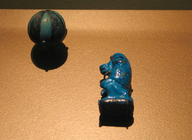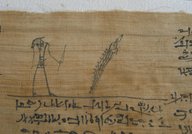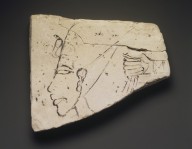Sculptor's trial piece
Period: New Kingdom, Ramesside or later
Dynasty: Dynasty 20
Reign: reign of Ramesses III or later
Date: ca. 1295–1070 B.C. or later
Geography: From Egypt
Medium: Limestone
Dimensions: H. 9.2 cm (3 5/8 in); W. 11.2 cm (4 7/16 in)
Credit Line: Gift of James Douglas, 1890
Accession Number: 90.6.144
Met Museum
metmuseum.org
domingo, 31 de mayo de 2015
Sculptor's trial piece with head of Isis
Sculptor's trial piece with head of Isis
Date
XXXVIth Dynasty
...
Date
XXXVIth Dynasty
...
Sculptor's Trial Piece
Sculptor's Trial Piece
- Medium: Limestone
- Place Made: Egypt
- Period: New Kingdom to Late Period
- Broolyn Museum
brooklynmuseum.org
Sculptor's Trial Piece showing a Nubian Head
Sculptor's Trial Piece showing a Nubian Head
Period: New Kingdom, Amarna Period
Dynasty: Dynasty 18
Reign: reign of Akhenaten
Date: ca. 1353–1336 B.C.
Geography: From Egypt, Middle Egypt, Amarna (Akhetaten); inc. el-Hagg Qandil, Sculptors' workshops in the town, Petrie excavations, 1891–92
Medium: Limestone, paint
Dimensions: h. 10.2 cm (4 in); w. 9 cm (3 9/16 in); d. 2 cm (13/16 in)
Credit Line: Rogers Fund, 1922
statuette
statuette
The arms are missing and there is some damage to the front of the legs. Parts of the surface are worn. This small stone figure represents one of the traditional enemies of Egypt. The long hair resting on the shoulders identifies the subject as a Libyan, who has been captured and bound. The hands are tied behind the back and the subject kneels. The feet are twisted in a manner that suggests the ankles are broken. At the top of the head is a small tenon (dowel hole), which suggests that the figure formed part of a larger object, perhaps a chair. Such images regularly appear on statues, furniture and thresholds of buildings. Similar images can also be found on temple reliefs. The ancient Egyptians traditionally believed that there were four races: Nubians, Libyans, Asiatics and themselves. Collectively foreigners were believed to threaten the order of the Egyptian world. They often appear as bound captives on the base of thrones and funerary cases or even on tiles, where they would be literally trampled under-foot. Pharaohs are often shown smiting their foreign enemies whilst holding them by their hair. Foreigners were, however, an important element of Egyptian society from Dynasty 6 (about 2300-2150 BC) onwards. At this period Libyans and Nubians joined the army as mercenaries. During Dynasty 26 (664-525 BC) Greeks were allowed to settle at Naukratis in the Delta; in this trading post they established Greek sanctuaries and worshipped Greek gods. In the sixth century BC Carians from southwest Asia Minor (Turkey) settled at Memphis and lived amongst Egyptians. Several foreign dynasties ruled Egypt, namely Hyksos (1650-1550 BC), Libyans (1069-664 BC), Kushites from modern-day Sudan (747-656 BC), Persians (525-404 BC and 343-332 BC), and Macedonian Greeks (332-30 BC). Like the Persians the Romans were non-resident pharaohs, but for a much longer period of time. It is perhaps because of their interest in Egyptian culture that there is an increase in production of images involving foreigners.
Third Dynasty
Old Kingdom
http://www.fitzmuseum.cam.ac.uk/
sábado, 30 de mayo de 2015
Ball Containing Pellets
Ball Containing Pellets
- Medium: Faience, painted
- Place Made: Egypt
- Dates: ca. 1539-1292 B.C.E.
- Dynasty: XVIII Dynasty
- Period: New Kingdom
- Dimensions: 1 1/4 x Diam. 1 1/4 in. (3.2 x 3.1 cm) (show scale)
- Collections:Egyptian, Classical, Ancient Near Eastern Art
- Museum Location:
 This item is on view in Egypt Reborn: Art for Eternity, Egyptian Orientation Gallery, 3rd Floor
This item is on view in Egypt Reborn: Art for Eternity, Egyptian Orientation Gallery, 3rd Floor - Exhibitions:
- Accession Number: 09.879
- Credit Line: Museum Collection Fund
- Rights Statement: Creative Commons-BYYou may download and use Brooklyn Museum images of this three-dimensional work in accordance with a Creative Commons license. Fair use, as understood under the United States Copyright Act, may also apply.
Please include caption information from this page and credit the Brooklyn Museum. If you need a high resolution file, please contact reproductions@brooklynmuseum.org (charges apply).
For further information about copyright, we recommend resources at the United States Library of Congress, Cornell University, Copyright and Cultural Institutions: Guidelines for U.S. Libraries, Archives, and Museums, and Copyright Watch.
For more information about the Museum's rights project, including how rights types are assigned, please see our blog posts on copyright.
If you have any information regarding this work and rights to it, please contact copyright@brooklynmuseum.org. - Caption: Ball Containing Pellets, ca. 1539-1292 B.C.E. Faience, painted, 1 1/4 x Diam. 1 1/4 in. (3.2 x 3.1 cm). Brooklyn Museum, Museum Collection Fund, 09.879. Creative Commons-BY
- Image: overall, CUR.09.879_36.125_erg456.jpg. Brooklyn Museum photograph, 9/5/2007
Mummy Bandage, Ii-em-hetep, born of Ta-remetj-hepu
Mummy Bandage, Ii-em-hetep, born of Ta-remetj-hepu
Spell 149, recorded on these bandages, describes fourteen underworld “mounds,” their landscape, inhabitants, and potential obstacles. This knowledge was believed to give power to the deceased and assist his or her transformation. The vignettes represent the geographical location of each “mound” and its properties. For instance, the pig-like creature with a long tail is associated with the fiery mound 12, while the standing hippo-crocodile deity, Hebed-eref (One Who Opens His Mouth), alludes to the watery location of mound 13.
This text refers to these objects: ' 37.2039.10E; 37.2039.14E
- Medium: Linen, ink
- Dates: 332 B.C.E. - 1st century C.E.
- Period: Ptolemaic Period, or later
- Dimensions: 3 3/8 x 18 1/2 in. (8.5 x 47 cm) Threads per square cm: Warp: 68 x Weft: 21 (show scale)
- Collections:Egyptian, Classical, Ancient Near Eastern Art
- Museum Location:
 This item is not on view
This item is not on view - Exhibitions:
- Accession Number: 37.2039.10E
- Credit Line: Charles Edwin Wilbour Fund
- Rights Statement: Creative Commons-BYYou may download and use Brooklyn Museum images of this three-dimensional work in accordance with a Creative Commons license. Fair use, as understood under the United States Copyright Act, may also apply.
Please include caption information from this page and credit the Brooklyn Museum. If you need a high resolution file, please contact reproductions@brooklynmuseum.org (charges apply).
For further information about copyright, we recommend resources at the United States Library of Congress, Cornell University, Copyright and Cultural Institutions: Guidelines for U.S. Libraries, Archives, and Museums, and Copyright Watch.
For more information about the Museum's rights project, including how rights types are assigned, please see our blog posts on copyright.
If you have any information regarding this work and rights to it, please contact copyright@brooklynmuseum.org. - Caption: Mummy Bandage, Ii-em-hetep, born of Ta-remetj-hepu, 332 B.C.E. - 1st century C.E. Linen, ink, 3 3/8 x 18 1Brooklyn Museum
brooklynmuseum.org
/2 in.Brooklyn Museum
brooklynmuseum.org
Figured Ostracon with Head of Akhenaten
Figured Ostracon with Head of Akhenaten
- Medium: Limestone, pigment
- Place Excavated: Tell el Amarna, Egypt
- Dates: ca. 1352–1336 B.C.E.
- Dynasty: Late XVIII Dynasty
- Period: New Kingdom, Amarna Period
- Dimensions: 4 11/16 x 5 5/8 x 1 in. (11.9 x 14.3 x 2.5 cm) (show scale)
- Signature: L
Brooklyn Museum
brooklynmuseum.org
martes, 26 de mayo de 2015
sarchophagus
Present location | RIJKSMUSEUM VAN OUDHEDEN [06/001] LEIDEN |
Inventory number | AMM 5-e |
Dating | 26TH DYNASTY |
Archaeological Site | UNKNOWN |
Category | COFFIN/SARCOPHAGUS OF HUMANS |
Material | WOOD; PLASTER |
Technique | PAINTED ON STUCCO |
Height | 36 cm |
Width | 63 cm |
Depth | 240 cm |
Bibliography
- Leemans, C., Aegyptische Monumenten van het Nederlandse Museum van Oudheden te Leiden III.30, Leiden 1890, pl. I-VIII.
- Schneider, H. D. en M. J. Raven, De Egyptische Oudheid, Den Haag 1981, nr. 127.
- Raven, M. J., De Dodencultus van het Oude Egypte, Amsterdam 1992, 60-62, nr. 23.
- Raven, M. J., Mummies onder het mes, Amsterdam 1993, afb. 117
globalegyptianmuseum
ivory, wood animal
Present location RIJKSMUSEUM VAN OUDHEDEN [06/001] LEIDEN
Inventory number AH 175
Dating MIDDLE KINGDOM
Archaeological Site UNKNOWN
Category UNSPECIFIED EQUIPEMNT ...
Material IVORY; WOOD
Technique SCULPTURED
Height 4.5 cm
Inventory number AH 175
Dating MIDDLE KINGDOM
Archaeological Site UNKNOWN
Category UNSPECIFIED EQUIPEMNT ...
Material IVORY; WOOD
Technique SCULPTURED
Height 4.5 cm
Bibliography•Leemans, C., Aegyptische Monumenten van het Nederlandse Museum van Oudheden te Leiden II.23, Leiden 1865, pl. CCXLIII, 494.
•Schneider, H. D., Egyptisch Kunsthandwerk, Amsterdam 1995, 78-79, nr. 32.
•Warmenbol, E., Ombres d'Égypte, Treignes 1999, 80, cat. nr. 51.
globalegyptianmuseum
•Schneider, H. D., Egyptisch Kunsthandwerk, Amsterdam 1995, 78-79, nr. 32.
•Warmenbol, E., Ombres d'Égypte, Treignes 1999, 80, cat. nr. 51.
globalegyptianmuseum
lunes, 25 de mayo de 2015
Suscribirse a:
Comentarios (Atom)















































